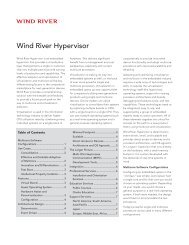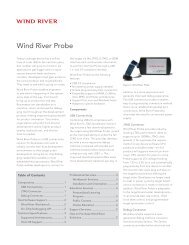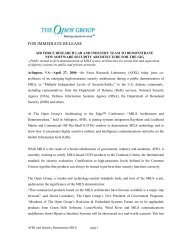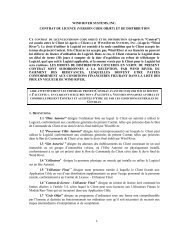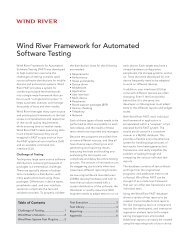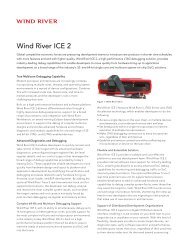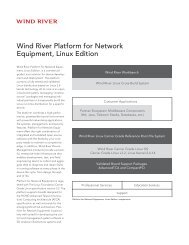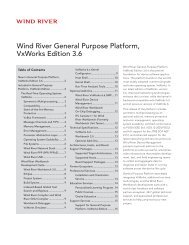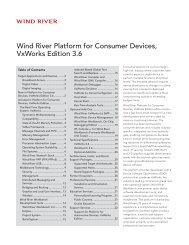6WINDGate™ - Architecture Overview - NE 6W-08-188 ... - Wind River
6WINDGate™ - Architecture Overview - NE 6W-08-188 ... - Wind River
6WINDGate™ - Architecture Overview - NE 6W-08-188 ... - Wind River
You also want an ePaper? Increase the reach of your titles
YUMPU automatically turns print PDFs into web optimized ePapers that Google loves.
4.4.3 IP Forwarding Example<br />
<strong>6W</strong>INDGate - <strong>Architecture</strong> <strong>Overview</strong> <strong>NE</strong> <strong>6W</strong>-<strong>08</strong>-<strong>188</strong> v1.0<br />
Model v1.1<br />
Page 26<br />
Figure 16 details how a Fast Pat module works using Fast Path IPv4 forwarding packet processing as an<br />
example.<br />
Figure 16: IPv4 Forwarding Packet Processing<br />
Fast Path packet processing is responsible for parsing the incoming packet and checking if it can be<br />
forwarded with the information available in the local memory.<br />
For that purpose, the following tests have to be performed to achieve the IPv4 forwarding function:<br />
• Firstly, Fast Path module is checking if the incoming packet has an IPv4 ethertype. If the test is<br />
negative, the packet is considered as an exception and diverted to the Slow Path (<strong>6W</strong>INDGate<br />
Networking Linux Stack) to be handled.<br />
• Then, the IPv4 packet is checked to detect packets that cannot be managed at the Fast Path<br />
level such as packets with wrong checksum, IP options or a TTL at 0. Broadcast/multicast<br />
packets as well as packets reserved IP destination addresses are also detected. If such an event<br />
occurs, the packet is considered as an exception and diverted to the Slow Path (<strong>6W</strong>INDGate<br />
Networking Linux Stack) to be handled.<br />
• Once done, if the packet has not been diverted, IP lookup takes place to check if there is valid<br />
entry in the routing table. IP lookup in <strong>6W</strong>INDGate IPv4 forwarding Fast Path module is<br />
implemented as M-trie 16/8/8 so that any flow is looked up within a fixed number of memory<br />
accesses to achieve the highest performance. As this stage, it is checked:<br />
o if a route is found for destination,<br />
o if the route found in the table is via a Slow Path interface. It can be for instance for a PCI<br />
or WiFi interface managed by the Slow Path,<br />
o if the route found in the table is via an unknown interface,<br />
If such an event occurs, the packet is considered as an exception and diverted to the Slow Path<br />
(<strong>6W</strong>INDGate Networking Linux Stack) to be handled.<br />
_________________________________________________________________________________________________________________<br />
<strong>6W</strong>IND Confidential. <strong>6W</strong>IND copyright 20<strong>08</strong>. All rights reserved. This document cannot be reproduced without <strong>6W</strong>IND written consent.







